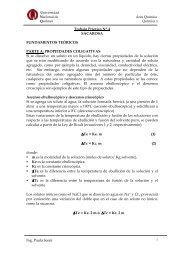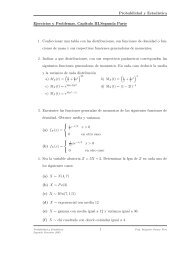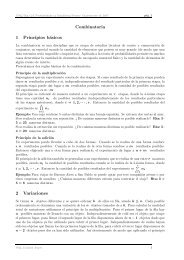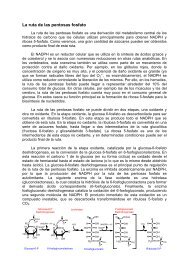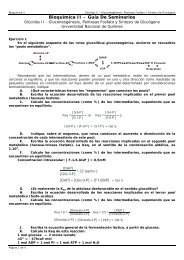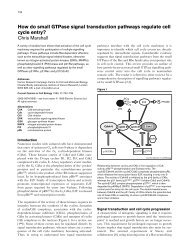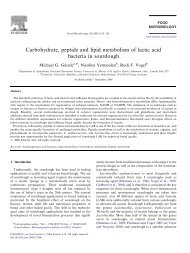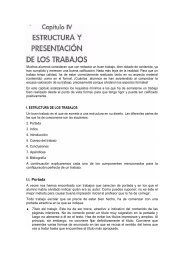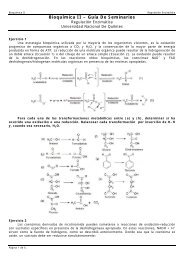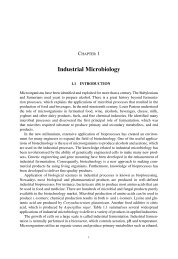ATP Sintasa. Clase Ciclo de Calvin.2011. - Materias.unq.edu.ar
ATP Sintasa. Clase Ciclo de Calvin.2011. - Materias.unq.edu.ar
ATP Sintasa. Clase Ciclo de Calvin.2011. - Materias.unq.edu.ar
Create successful ePaper yourself
Turn your PDF publications into a flip-book with our unique Google optimized e-Paper software.
Transporte <strong>de</strong> electrones Traslocación <strong>de</strong> protonesLado N (----)Lado P (++++)
EstromaTransporte <strong>de</strong> electrones Traslocación <strong>de</strong> protones2H 2 O + 2NADP + +8 fotones2H + 6H + 1H +4H + 4H + 2H +O 2 + 2NADPH +2H +2 fotones/e -(1 por cada PS)2H +8H +Fotosíntesis linealPor cada O 2 generado Traslocación <strong>de</strong> 11H +3,7 <strong>ATP</strong>Fotosíntesis cíclica(2 fotones 2 e-)Traslocación <strong>de</strong> 4H +21,3 <strong>ATP</strong>(5,3 <strong>ATP</strong> / 8 fotones)4H +Lumen <strong>de</strong>l tilacoi<strong>de</strong>1 foton/e -(PSI)
Hipótesis Quimio-osmótica1960s: Generación <strong>de</strong> <strong>ATP</strong> Fosforilación a nivel <strong>de</strong> sustrato¿Cuál es el metabolito intermedi<strong>ar</strong>io rico en energía en lamitocondria?Hipótesis: un gradiente <strong>de</strong> concentración <strong>de</strong> protones sirvecomo reservorio <strong>de</strong> energía p<strong>ar</strong>a dirigir la formación <strong>de</strong> <strong>ATP</strong>.I. Experimentos <strong>de</strong> medición <strong>de</strong> potenciales <strong>de</strong> membrana y observación <strong>de</strong>lefecto <strong>de</strong>l uso <strong>de</strong> agentes <strong>de</strong>sacoplantes <strong>de</strong> la ca<strong>de</strong>na <strong>de</strong> transporte <strong>de</strong>electrones.II.Postulados:1) Una membrana mitocondrial intacta es un requerimiento absoluto p<strong>ar</strong>a elacoplamiento entre el gradiente <strong>de</strong> protones y la generación <strong>de</strong> <strong>ATP</strong>. Lamembrana <strong>de</strong>be ser impermeable a los solutos c<strong>ar</strong>gados. Transportadoresespecíficos permiten su paso a través <strong>de</strong> la membrana.2) El transporte <strong>de</strong> electrones a través <strong>de</strong> una ca<strong>de</strong>na <strong>de</strong> transporteelectrónico, genera un gradiente <strong>de</strong> concentración <strong>de</strong> protones.3) Una enzima unida a membrana, la <strong>ATP</strong> sintasa, cataliza la fosforilación <strong>de</strong>lADP.The aspect of the present position of consensus that I find most rem<strong>ar</strong>kable and admirable, is thealtruism and generosity with which former opponents of the chemiosmotic hypothesis have not onlycome to accept it, but have actively promoted it to the status of a theory.Premio Nobel, 1978.
Hipótesis Quimio-osmótica15%85%
Traslocación <strong>de</strong> protones Energía
Síntesis <strong>de</strong> <strong>ATP</strong> <strong>ATP</strong> <strong>Sintasa</strong><strong>ATP</strong> sintasatipo FCada subunidad β pue<strong>de</strong>asumir 3 diferentesconformaciones
Síntesis <strong>de</strong> <strong>ATP</strong> Mecanismo <strong>ATP</strong> <strong>Sintasa</strong>1. DÉBILAl menos 2 <strong>de</strong> los 3sitios catalíticos <strong>de</strong>benest<strong>ar</strong> activos el <strong>ATP</strong>no pue<strong>de</strong> liber<strong>ar</strong>se <strong>de</strong>un sitio al menos queun ADP + Pi esténunidos en otro.2. FUERTE 3. ABIERTA
Mecanismo <strong>ATP</strong> <strong>Sintasa</strong> Rotación <strong>de</strong> Fo y la subunidad GammaF1 + His tag Adherido a un portaobjetocubierto con Ni+2 Biotina + Sub. C <strong>de</strong> Fo Avidina + Filamentos <strong>de</strong> actina*Unión Biotina-Avidina Suministro <strong>de</strong> <strong>ATP</strong> El filamento m<strong>ar</strong>cado rota continuamente Las sub. C que forman el cilindro <strong>de</strong> Forotan
http://www.youtube.com/watch?v=2RhLCpeu7cEVi<strong>de</strong>o
Intercambio <strong>ATP</strong>-Pi31Rendimiento en euc<strong>ar</strong>iotas 4H + rin<strong>de</strong>n 1 <strong>ATP</strong>RECORDAR: El mecanismo <strong>de</strong> la <strong>ATP</strong>asa emplea 3H +
Proceso Producto directo <strong>ATP</strong> finalGlucólisis 2 <strong>ATP</strong> 3 ó 52 NADH (citosol)Rendimiento <strong>de</strong> <strong>ATP</strong>Lanza<strong>de</strong>ra Malato-Asp<strong>ar</strong>tatoNADH cit NADH mitHígado, riñón y corazón.Lanza<strong>de</strong>ra Glicerol 3PNADH cit QH 2mitMúsculo esquelético y cerebro.
Proceso Producto directo <strong>ATP</strong> finalGlucólisis 2 <strong>ATP</strong> 3 ó 52 NADH (citosol)Rendimiento <strong>de</strong> <strong>ATP</strong>NAD(P)H Deshidrogenasa ExternaNAD(P)H cit QH 2mitPlantas.Algunas plantas elevan la temperatura <strong>de</strong>rriten la nieve,moléculas con olor p<strong>ar</strong>a atraer insectos polinizadores
Rendimiento <strong>de</strong> <strong>ATP</strong>Oxidación completa <strong>de</strong> la glucosaProceso Producto directo <strong>ATP</strong> finalGlucólisis 2 <strong>ATP</strong> 52 NADH (citosol)Oxidación 2 NADH (matriz mit.) 5Piruvato (2)AcCoA en Krebs 6 NADH (matriz mit.) 15(2)2 QH 2 62 <strong>ATP</strong> ó GTP 2Total 32
Rendimiento <strong>de</strong> <strong>ATP</strong>¿Cómo sería la ecuación global final?Glucosa + 10 NAD + + 2Q + 6H 2 O 6CO 2 + 10 NADH + 10 H + + 2 QH 24 ADP + 4Pi 4<strong>ATP</strong> + 4H 2 OGlucosa + 10 NAD + + 2Q + 2H 2 O 6CO 2 + 10 NADH + 10 H + + 2 QH 2+ 4ADP + 4Pi + 4<strong>ATP</strong>¿Y si traducimos coenzimas a H + y <strong>de</strong>spués <strong>ATP</strong> ?1 NADH 10 H + 10 NADH son 100 H+1 QH 2 6 H + 2 QH 2 son 12 H +4 H + 1<strong>ATP</strong> 112 H + 28<strong>ATP</strong>112 H +3H +p<strong>ar</strong>a <strong>ATP</strong>asa + 1H + intercambio PiGlucosa + 2H 2 O + 4ADP + 4Pi 6CO 2 + 4<strong>ATP</strong>28 ADP + 28Pi 28<strong>ATP</strong> + 28H 2 OGlucosa + 32ADP + 32Pi 6CO 2 + 32<strong>ATP</strong> + 26H 2 O
Glucosa + 32ADP + 32Pi 6CO 2 + 32<strong>ATP</strong> + 26H 2 ORendimiento <strong>de</strong> <strong>ATP</strong>¿Falta algo? ¿Y qué más?El aceptor finaaaaaaaaal !!!!!NADH o QH 2Tenemos 12 coenzimas 10NADH + 2 QH 22e -son transferidos a 1/2 O 2 1H 2 OTenemos 12 coenzimas 10NADH + 2 QH 2Glucosa + 32ADP + 32Pi 6CO 2 + 32<strong>ATP</strong> + 26H 2 O6O 212H 2 OGlucosa + 32ADP + 32Pi + 6O 26CO 2 + 32<strong>ATP</strong> + 38H 2 O
Obtención <strong>de</strong> Energía
Fijación <strong>de</strong> CO2: <strong>Ciclo</strong> <strong>de</strong> las pentosas r<strong>edu</strong>ctivo, ó ciclo <strong>de</strong> Calvin
Fijación <strong>de</strong> CO2: <strong>Ciclo</strong> <strong>de</strong> las pentosas r<strong>edu</strong>ctivo, ó ciclo <strong>de</strong> CalvinChlorella pyrenoidosaDetoxificación <strong>de</strong> mercurio porChlorella pyrenoidosa
Fijación <strong>de</strong> CO2: <strong>Ciclo</strong> <strong>de</strong> las pentosas r<strong>edu</strong>ctivo, ó ciclo <strong>de</strong> CalvinChlorella pyrenoidosaahora en tabletas!!!!
RhodobacterEstructuras presentes en bacterias involucradas en la generación <strong>de</strong> energíaProchloronAscidios
CyanobacteriasEstructuras presentes en bacterias involucradas en la generación <strong>de</strong> energíaMorfología <strong>de</strong> unacianobacteria i<strong>de</strong>al:a.- Membrana externa; b.-Capa <strong>de</strong> peptidoglucano; c.-Membrana plasmática; d.-Citosol; e.- Gránulo <strong>de</strong>cianoficina; f.- Ribosoma; g.-Gránulo <strong>de</strong> glucógeno; h.-Cuerpo lipídico; i.-C<strong>ar</strong>boxisoma; j.- Ficobilisoma.k.- Gránulo polifosfato; l.-Vacuola gasífera; m.-Tilacoi<strong>de</strong>; n.- ADN.
Estructuras presentes en plantas involucradas en la toma <strong>de</strong>l CO2 y generación <strong>de</strong> energíaEstomasCloroplastoTransporte <strong>de</strong> electronesdurante la fase cl<strong>ar</strong>aEstroma/CitoplasmaLumen <strong>de</strong>l tilacoi<strong>de</strong>/Periplasma
Resumen <strong>de</strong> reacciones <strong>de</strong> las fases cl<strong>ar</strong>a y oscurapH, Mg+2
RuBisCO: Ribulosa 1,5-Bis fosfato C<strong>ar</strong>boxilasa/Oxigenasa8 subunida<strong>de</strong>s catalíticas y 8pequeñas subunida<strong>de</strong>s (L8S8)Inmunofluorescencia sobre RuBisCO <strong>de</strong> Arundinella raddi, una gramíneaampliamente distribuída en el mundo.La RuBisCO constituye aproximadamente el 50 % <strong>de</strong> la proteína soluble enlas hojas <strong>de</strong> las plantas, siendo una <strong>de</strong> las más abundantes proteínas en lanaturaleza.K MCO2 =12 µM y K MO2 = 250 µM
RuBisCO: Mecanismo <strong>de</strong> acción p<strong>ar</strong>a la C<strong>ar</strong>boxilación--BHCH 2OP--B - C O H +H C OH EnolizaciónHOHCOHCH 2OPRibulosa 1,5-BisPCH 2 OPC-COOHRupturaClivaje--BHHOHO--BHCH 2OPCCHCOHOOHCH 2OPHOCOIntermedi<strong>ar</strong>io 2,3-enediolCH 2OPCCHCCOOHOOHCH 2OPIntermedi<strong>ar</strong>io 3-gemdiolHidrataciónC<strong>ar</strong>boxilaciónCH 2OP--BH HO C COOHCHCOOHCH 2OP: OHIntermedi<strong>ar</strong>io ceto<strong>ar</strong>abitinolHProtonaciónO OHHCC OHCH 2OP3-fosfo Glicerato (3PG)O OHHCC OHCH 2OP3-fosfo Glicerato (3PG)
RuBisCO: Mecanismo <strong>de</strong> acción p<strong>ar</strong>a la OxigenaciónCH 2OP--B - C O H +H C OH EnolizaciónHCOHCH 2OPRibulosa 1,5-BisPHOCH 2OPCOFosfoglicolatoH 2O--BHCH 2OPCCHCOHOOHCH 2OPHOOIntermedi<strong>ar</strong>io 2,3-enediolCH 2OP--BHCHO- O OHOHCCOHOHCH 2OP3-fosfo Glicerato (3PG)Clivaje Ruptura--BH--BHHO-OOxigenaciónHOOCH 2OPCCHCHidrataciónCH 2OPCCHCOOHOHCH 2OPOOHCH 2OPOHOH:O HHIntermedi<strong>ar</strong>io ceto<strong>ar</strong>abitinolIntermedi<strong>ar</strong>io 3-gemdiolH +
Ecuación Global3CO2 + 9 <strong>ATP</strong> + 6 NADPH + 5 H2O9 ADP + 8 Pi + 6 NADP+ + Triosa-P
Destinos <strong>de</strong> las Triosas-P sintetizadas mediante la fijación <strong>de</strong>l CO2
Síntesis <strong>de</strong> sac<strong>ar</strong>osa: el azúc<strong>ar</strong> móvil <strong>de</strong> las plantas
Adaptaciones <strong>de</strong> las plantas p<strong>ar</strong>a disminuir la tasa <strong>de</strong> fotorespiraciónC4CAMEstrategiaespacialEstrategiatemporalM<strong>ar</strong>shall Hatch y Roger Slack, 1960sAprox. 5 % <strong>de</strong> las plantas terrestresS. L. Ranson y M. Thomas, 1940sSe conocen 33 familias con 15 a 20mil especies (7 % <strong>de</strong> las plantas)
Estrategia espacial: Metabolismo C4 (Intermedi<strong>ar</strong>io <strong>de</strong> 4 c<strong>ar</strong>bonos)Resumiendo.Estructura celul<strong>ar</strong> <strong>de</strong> la hoja <strong>de</strong> plantas C3 y C4 (Kranz)En una hoja C3, las células <strong>de</strong>l mesófilo en empalizada, típicamente forman una capa en la p<strong>ar</strong>te exterior <strong>de</strong> la hoja; lasmismas células <strong>de</strong>l mesófilo en una planta C4 están usualmente or<strong>de</strong>nadas en forma <strong>de</strong> anillo alre<strong>de</strong>dor <strong>de</strong> las células <strong>de</strong> lavaina <strong>de</strong>l haz. Estas células tienen cloroplastos (ver<strong>de</strong> oscuro), mientras que las hojas <strong>de</strong> C3 c<strong>ar</strong>ecen <strong>de</strong> este tipo <strong>de</strong>organelas en esta localización. Estos cloroplastos son diferentes a los que se observan en las células <strong>de</strong>l mesófilo: los <strong>de</strong> lavaina <strong>de</strong>l haz tienen pequeños grana y tienen granos <strong>de</strong> almidón, mientras que en las células <strong>de</strong>l mesófilo ocurre lo contr<strong>ar</strong>io.
Estrategia espacial: Metabolismo C4 (Intermedi<strong>ar</strong>io <strong>de</strong> 4 c<strong>ar</strong>bonos)Las plantas <strong>de</strong>lgénero Atriplex,incluyen especies C3y C4. De los datosque se presentan ellos gráficos (especie1: curva negra;especie 2: curv<strong>ar</strong>oja). ¿Cuál es C3 ycuál C4?Cultivo <strong>de</strong> maízLa tasa <strong>de</strong> fotonsíntesis aumenta con laintensidad <strong>de</strong> luz, dando como resultadoun aumento <strong>de</strong> la fotorrespiración,perdiendo la capacidad <strong>de</strong> fijación <strong>de</strong> CO2en plantas C3.La afinidad <strong>de</strong> la RuBisCOpor el CO2 disminuye conla temperaturaSe genera unaatmósfera rica en CO2,<strong>de</strong>bido a la organizacióncelul<strong>ar</strong>Amazonas
Estrategia temporal: Metabolismo CAM (Craussulasean Acid Metabolism)BromeliáceaLas cuatro fases <strong>de</strong>l CAM. La fase 1 es laabsorción <strong>de</strong> CO2 en la oscuridad. Este CO2 esalmacenado como un grupo c<strong>ar</strong>boxilo (COO-)<strong>de</strong>l malato. La fase 2 es la absorción <strong>de</strong> CO2 porla mañana temprano por medio <strong>de</strong> fotosíntesis<strong>de</strong> tipo C3 normal. La fase 3 es la absorción nula<strong>de</strong> CO2 a la luz. El malato es <strong>de</strong>sc<strong>ar</strong>boxilado y elCO2 resultante es asimilado. La fase 4 es laabsorción <strong>de</strong> CO2 al final <strong>de</strong> la t<strong>ar</strong><strong>de</strong> porfotosíntesis <strong>de</strong> tipo C3 normal, simil<strong>ar</strong> a la fase2. Estas fases no siempre son observadas entodas las plantas CAM (Azcón-Bieto & Talón1993).
Estrategia temporal: Metabolismo CAM (Craussulasean Acid Metabolism)Malato
Resumiendo.Cuadro comp<strong>ar</strong>ativo <strong>de</strong> las diferentes vías <strong>de</strong> fijación <strong>de</strong> CO2



